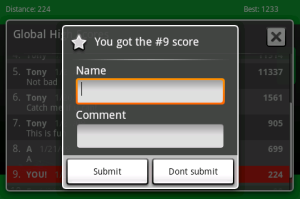 Check out this Samsung Galaxy S II Multi Touch video. You can press all 10 fingers on the screen at once, with accurate tracking even when fingers are close together. That’s what I call true multi-touch.
Check out this Samsung Galaxy S II Multi Touch video. You can press all 10 fingers on the screen at once, with accurate tracking even when fingers are close together. That’s what I call true multi-touch.
Month: April 2011
First week on the Android Market
 It’s over a week now since I uploaded the finished version of Tap That! Number to the Android Market. Some people have been asking how the app is going now, so I thought I’d share with you some statistics and figures from the past week or so.
It’s over a week now since I uploaded the finished version of Tap That! Number to the Android Market. Some people have been asking how the app is going now, so I thought I’d share with you some statistics and figures from the past week or so.
Samsung Galaxy S II vs. HTC Sensation – Which is best?
 The two hottest smartphones announced this year are the Samsung Galaxy S II, and the HTC Sensation. Both devices have fantastic specs and a huge 4.3″ screen. But at the end of the day, which one performs best? Which one should you buy? Read on for a full comparison, including a color-coded table showing where each phone wins in specifications.
The two hottest smartphones announced this year are the Samsung Galaxy S II, and the HTC Sensation. Both devices have fantastic specs and a huge 4.3″ screen. But at the end of the day, which one performs best? Which one should you buy? Read on for a full comparison, including a color-coded table showing where each phone wins in specifications.
How to use ScoreNinja for Android App High Scores
 My latest application, Tap That! Number uses the ScoreNinja library to integrate global high scores. This library is very easy to include with only a few lines of code. Other solutions such as ScoreLoop try to bundle a full social framework, but ScoreNinja does just one thing – global high scores. In this post I’ll teach you how to integrate ScoreNinja into your own Android app.
My latest application, Tap That! Number uses the ScoreNinja library to integrate global high scores. This library is very easy to include with only a few lines of code. Other solutions such as ScoreLoop try to bundle a full social framework, but ScoreNinja does just one thing – global high scores. In this post I’ll teach you how to integrate ScoreNinja into your own Android app.
Introducing: Tap That! Number
 My first Android app is now published and live on the Android Market! As I mentioned in an earlier post, this is a casual game and my first attempt at integrating the AdMob SDK into an Android app.
My first Android app is now published and live on the Android Market! As I mentioned in an earlier post, this is a casual game and my first attempt at integrating the AdMob SDK into an Android app.
Tap That! Number for Android
Download from the Android Market
Download from AppBrain
Download from SlideME
The aim of the game is simple – to tap all the numbers from 1 to 25 in sequence, in the fastest possible time.
This app is actually a great starting point for developing an Android game. While the concept is simple, this implementation makes use of custom views, UI themes, threading, and integration of a third-party high score system. It has several activities, and involves basic application life-cycle management (especially handling the threads).
A developer success story
The developer of Camera+ (for iOS devices) recently announced that their app has hit 2 million sales. This figure is a huge success, both numerically and financially. To celebrate this milestone, the developers have decided to share some of their stats publicly, including overall sales volume and revenue from in-app purchases. One of the most … Read more
How to run Android Market on the Emulator
During development, it is often useful to be able to test the Android Market from a device other than your own. However, by default the Android emulator doesn’t include the Android Market – nor offer an easy method of installing it. This tutorial will show you how to setup an Android Virtual Device (AVD) running … Read more
Protecting from Cyber Attackers
Cyber attackers are constantly looking for new ways to gain access to networks. They target servers that run old and poorly-maintained software on purpose. So it’s quite unlikely that hackers will stop looking for opportunities to break into networks. However, they are finding that certain technologies, like the use of firewalls and intrusion prevention systems … Read more
How to Make Money with Android
So you want to make money with Android? Sell your Android apps to make a profit? Generate enough revenues from your Android apps that you can quit your job and live off the earnings? Or just learn how to monetize your existing apps? You’ve come to the right place. This blog will be a journal … Read more